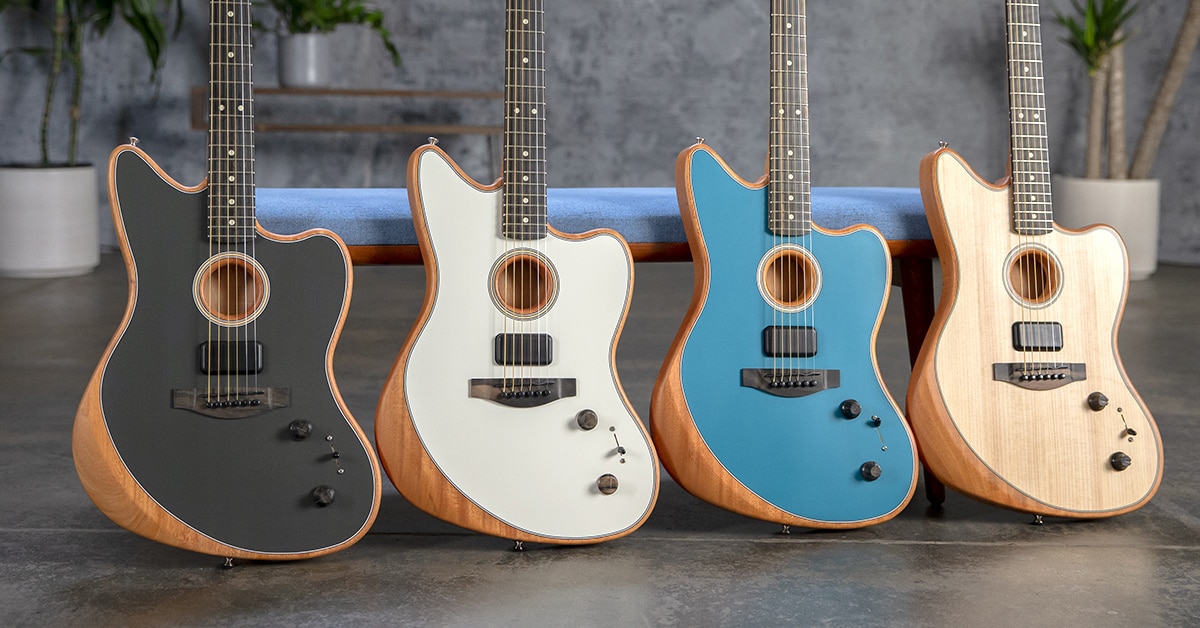Fender has announced the Acoustasonic Jazzmaster, the third member of a groundbreaking acoustic-electric guitar family first introduced in 2019. With its new Tim Shaw-designed Acoustasonic Shawbucker pickup, the Jazzmaster offers players ten unique voices, ranging from classic acoustic sounds to the more aggressive electric sounds long associated with this offset indie icon.
We reached out to Fender’s pickup guru, and Shawbucker namesake, Tim Shaw, to learn more about this exciting new addition to the Acoustasonic lineup.
The HUB: Fender started the family with the Acoustasonic Telecaster in 2019 and followed with the Acoustasonic Stratocaster in 2020. Three models in, how do you find a Jazzmaster voice in this unique platform?
Tim Shaw: There are different Jazzmaster voices throughout Fender’s history. In this case, we’d already focused on the idea of the Jazzmaster in its indie mode, as opposed to its earlier surf mode. That gave us the freedom to do a hot humbucker, rather than the original pickup design.
The HUB: How do you approach designing a pickup for an acoustic guitar, as compared to your typical electric projects?
TS: Guitars are systems, so the way the pickup interacts with the body is different than it is on a solid body guitar. In this case, we also have an acoustic bridge and saddle instead of a metal one. All of these pushed us to a design that was hotter than it might have been in a more typical electric design.

The HUB: Building on that a little bit, can you speak to how other qualities of the instrument may have impacted your design?
TS: The Acoustasonic Jazzmaster is unique. As an acoustic instrument, it’s pretty full-sounding for its size, so we’re getting more lows and low-mids out of the body than we were with the Acoustasonic Telecaster and Stratocaster.
This, and the fact that we had an acoustic bridge and saddle, meant we didn’t have the normal attack we’d get from an electric guitar. The pickup had to carry more of that load in the way it read the strings.
The HUB: Did you have a specific sound in mind as you started the project?
TS: I knew we’d need a more traditional dual-coil pickup design to get that classic midrange crunch when the player’s selecting an overdriven sound. That gave me a starting point for the designs.
The HUB: What role does the humbucker play in regard to the larger Fishman electronics system?
TS: The electronics and the pickups are their own system, and we’d thought all along we wanted a humbucking voice for this model. I went through six variations of the pickup before we got one that responded well in the “Overdrive” mode (position 1B) that we heard in our heads as we developed and voiced the guitar.

The HUB: Does the acoustic string material make a significant difference that you have to design for as compared to electric strings?
TS: With bronze strings, we’re only hearing the core wire, since the bronze wraps aren’t magnetic. That means a regular humbucking design can sound thin; it’s as if you’re hearing a guitar with only plain strings.
The HUB: Is there anything unique to the design of this pickup as compared to a typical electric pickup?
TS: There are a few interesting things here. To keep the clean look of the other Acoustasonic models, we’re adjusting the pole pieces from the back of the pickup, and these are preset for the correct string balance during assembly.
As with other humbuckers, the pole pieces are steel, and here we use an Alnico 2 magnet under the coils. This means the pickup sits closer to the strings than it does on other Acoustasonic models, which have alnico rod magnets.
And, as I’ve mentioned, this would be a fairly high-output pickup if we installed it in a typical electric guitar, and it was wound to be hotter to get the desired results with acoustic strings and the structure of the Acoustasonic Jazzmaster body.
The HUB: Very cool. Well, thanks for your time, Tim. Always a pleasure.







































































































































